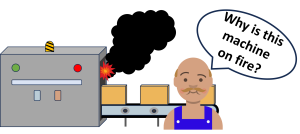The 5 Whys
Background: This technique was developed in the 1930s by the founder of Toyota, Sakichi Toyoda. He noticed that the same problems kept arising with the machinery in his factory, and he discovered that by continuing to ask the question ‘why?’, he could find the root cause of a problem, rather than just finding a temporary solution.
How do I use the 5 Whys?
- Write down the problem you are trying to address.
- Ask yourself why the problem occurs and write down your answer.
- Repeat the first two steps and continue until you have identified what you believe to be the root cause of the problem.
- You can aim to ask at least five ‘whys’, but when asking why produces no more useful responses – you’ve reached the root cause.
An example of the 5 Whys from the manufacturing industry might look something like this:
Problem: We couldn’t finish today’s production because a machine broke down.
Why did the machine break down?
Because it overheated.
Why did it overheat?
Because there was insufficient lubrication on the bearings.
Why was there insufficient lubrication on the bearings?
Because the oil pump that injects the lubricant was blocked.
Why was the oil pump blocked?
Because it was filled with metal shavings.
Why was it filled with metal shavings?
Because the filtration system was malfunctioning and needed replacing.
Solution: replace the filtration system.
This example shows us that if we only provide a solution for the first or second ‘why’, the problem will just come up again. However, if we continue to ask ‘why’, we can come to the root cause of the problem. If we provide a solution to that problem, then it’s much more likely to be a permanent solution.

How the 5 Whys can be used in other situations:
Let’s observe how the 5 Whys can be used in a range of scenarios.
We’ll start with Miguel, who has just finished a Bachelor of Applied Science (Medical Radiations). He’s applied for a number of jobs as a radiographer in the last month but hasn’t had any luck. He’s decided to use the 5 Whys problem-solving technique to help him develop a better answer to a common interview question.
Ari’s partner has just broken up with him. His relationships always seem to end after a few months, and he’d like to prevent future heartache. He’s decided to use the 5 Whys to figure out the root cause of his relationship failures.
Reflect
- Can you think of a time when you initially only addressed the symptoms of a problem without trying to discover the root cause? What did you learn from that experience?
- The 5 Whys strategy isn’t only useful for solving problems, it’s also helpful when you’re setting goals and making future decisions. How could you use this strategy to help you plan your career?
Imagine that a good friend tells you that they’ve been in a ‘bad mood’ all week, how might your conversation go if you use the 5 Whys to figure out the cause of their low spirits?
Read one possible scenario below to get some ideas, and then come up with your own, starting with the question: Why do you think you’re in a bad mood?
“Why do you think you’re in a bad mood?”
“I don’t know! Everyone is annoying me, and I have no patience at all.”
“Why do you think you feel that way?”
“Probably because I’m so tired.”
“Why are you tired?”
“I haven’t been sleeping well lately.”
“Why not?”
“I keep waking up all the time because it’s too hot in my room.”
“Why is it so hot in your room?”
“Well, it’s summer and my air-conditioner is broken! How many more questions are you going to ask me?!”
A-ha! You don’t need to ask them any more questions – your grumpy friend hasn’t been sleeping well, and it seems that the solution is for them to get their air-conditioner fixed.
Different approaches are needed for different types of problems. Now that you know how to use the 5 Whys, learn about the working backwards technique and how to visualise the parts of a problem using a mind map.
This page includes content adapted from Tools & Templates: Five Whys by the Strategy Unit licensed under CC BY-NC-ND 4.0
